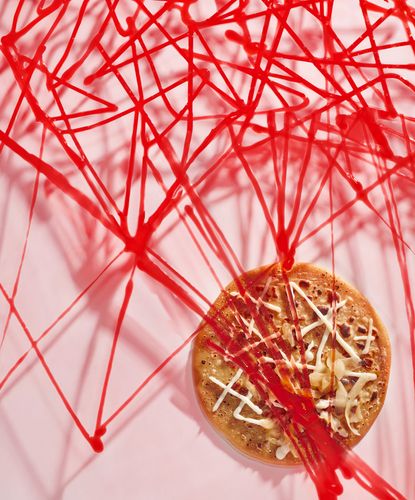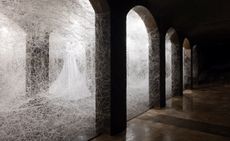Artist’s Palate: Chiharu Shiota’s recipe for okonomiyaki
Get tangled up in Chiharu Shiota’s recipe for okonomiyaki, from our January 2023 issue’s Artist’s Palate feature, a Wallpaper* homage to our favourite contemporary art
- (opens in new tab)
- (opens in new tab)
- (opens in new tab)
- Sign up to our newsletter Newsletter

Memory plays an integral role in the work of Berlin-based Japanese installation artist Chiharu Shiota. For an early work, A Room of Memory, she used 1,000 discarded windows from derelict buildings in former East Germany to construct a tower, inviting viewers to enter and ponder the past lives that these windows had framed. Whereas her Japan pavilion for the 2015 Venice Biennale, The Key in the Hand, entangled more than 50,000 keys collected from volunteers around the world in a labyrinth of red thread. ‘The keys are imbued with various recollections and memories that have accumulated over a long period of daily use. As I create the work, the memories of everyone who provides me with the keys will overlap with my own memories,’ she said at the time.
Shiota’s dish for our Artist’s Palate series comes with a similar dash of nostalgia: okonomiyaki is thought to have originated in Osaka, where she was born. ‘I've been eating it since I was little,’ she explains. ‘I've been in Berlin for 26 years now, and sometimes I crave the taste of okonomiyaki sauce. German cabbage is so delicious that I often make it at home. It tastes like home.’
Chiharu Shiota's recipe for okonomiyaki
Ingredients: (for two pancakes)
Pancakes
100g flour
75ml dashi stock
1 tsp milk
1 tsp tsuyu sauce
3 eggs
150g cabbage, chopped roughly
2 tsp beni shoga (pickled ginger)
2 tbsp vegetable oil
100g pork belly, thinly sliced
1 tbsp Kewpie mayonnaise
1 tsp katsuobushi (bonito flakes)
1 tsp aonori (seaweed flakes)
Okonomiyaki sauce
1 tbsp Worcester sauce
1 tbsp oyster sauce
2 tbsp ketchup
1 tbsp honey
1 tsp soy sauce
Method
To make the sauce, mix all the ingredients in a bowl, then set aside.
To make the batter, sift the flour into a large bowl. Add the dashi stock, milk, tsuyu sauce and one egg to the bowl, then mix well until there are no lumps. Do not over-mix. Cover the bowl with plastic wrap and place it in the fridge for 30 minutes.
Put half the batter in a bowl, then add half the cabbage, half the beni shoga and one egg. Mix well. Heat a frying pan on medium-high heat, then add a tablespoon of vegetable oil. Once hot, add the cabbage mixture to the centre of the frying pan, then lay some pork belly slices on top. Fry until the bottom starts to become brown and crispy, then carefully flip it. Place a lid on the pan and cook for about 5 minutes on medium-low heat. Pierce the middle with a toothpick to make sure it’s cooked. If the toothpick doesn’t come out clean, it’s not quite ready and you need to continue to cook on low heat, checking regularly.
Once it’s cooked through, flip it again and pour half of the sauce on top, using a pastry brush or spoon to spread it evenly. Serve drizzled with mayonnaise and sprinkled with bonito and seaweed flakes.
Repeat the process with the remaining ingredients. Enjoy!
‘Invisible Line’ runs until 16 April 2023 at ARoS, Aarhus, aros.dk (opens in new tab); chiharu-shiota.com (opens in new tab)
TF has been editor of Wallpaper* since December 2020. He is responsible for our monthly print magazine, planning, commissioning, editing and writing long-lead content across all our content pillars. He also plays a leading role in multi-channel editorial franchises, such as our annual Design Awards, Guest Editor takeovers and Next Generation series. He aims to create world-class, visually-driven content while championing diversity, international representation and social impact. TF joined Wallpaper* as an intern in January 2013, and served as its commissioning editor from 2017-20, winning a 30 under 30 New Talent Award from the Professional Publishers’ Association. Born and raised in Hong Kong, he holds an undergraduate degree in history from Princeton University.
-
 2022 fashion highlights, as picked by the Wallpaper* team
2022 fashion highlights, as picked by the Wallpaper* teamThe Wallpaper* fashion and beauty team reflect on their personal 2022 fashion highlights – from Gaetano Pesce at Bottega Veneta and Wales Bonner in Florence to intrigue and seduction at Prada
By Jack Moss • Published
-
 Marre Moerel’s swinging flame candle uses artful balance
Marre Moerel’s swinging flame candle uses artful balanceVita Balanza by Marre Moerel and Santa & Cole has turned candles into a balancing act
By Martha Elliott • Published
-
 At home with Neri & Hu
At home with Neri & HuArchitectural super-pair Neri & Hu talk to us about what inspires them, what they are reading, and how they switch off
By Ellie Stathaki • Published
-
 Artist’s Palate: Jose Dávila’s chocolate fudge with pecans
Artist’s Palate: Jose Dávila’s chocolate fudge with pecansTry Jose Dávila’s indulgent recipe for chocolate fudge with pecans, from our December 2022 issue’s Artist’s Palate feature, a Wallpaper* homage to our favourite contemporary art
By TF Chan • Published
-
 ‘East Meets West’: artists Samiro Yunoki and Kori Girard unite at Ace Hotel Kyoto
‘East Meets West’: artists Samiro Yunoki and Kori Girard unite at Ace Hotel KyotoArt exhibition, ‘East Meets West’ at Ace Hotel Kyoto marks Japanese artist Samiro Yunoki’s 100th birthday, in dialogue with new works by American artist Kori Girard
By Pei-Ru Keh • Last updated
-
 teamLab: how a Tokyo art collective pioneered an immersive art boom
teamLab: how a Tokyo art collective pioneered an immersive art boomWith an operatic intervention and a show at Pace Geneva, teamLab, the now-700-strong Tokyo-based collective that blazed a trail for experiential, tech-fuelled art, continues to value ‘physical interaction in physical space’
By Nick Compton • Last updated
-
 Tanabe Chikuunsai IV wraps Casa Loewe Barcelona in 6,000 strips of tiger bamboo
Tanabe Chikuunsai IV wraps Casa Loewe Barcelona in 6,000 strips of tiger bambooInside the newly revamped Casa Loewe Barcelona, Japanese artist Tanabe Chikuunsai IV reflects on family traditions and environmental destruction with a staggering bamboo installation
By Malaika Byng • Last updated
-
 Botanical sculptor Azuma Makoto creates a sculptural ecosystem at Mexico’s SFER IK
Botanical sculptor Azuma Makoto creates a sculptural ecosystem at Mexico’s SFER IKJapanese artist Azuma Makoto’s largest flower sculpture to date responds to SFER IK’s unique biophilic design and the surrounding wilderness
By Pei-Ru Keh • Last updated
-
 Valley Gallery by Tadao Ando is Naoshima's newest art pilgrimage site
Valley Gallery by Tadao Ando is Naoshima's newest art pilgrimage siteThe latest addition to Japan’s Benesse Art Site, Tadao Ando’s Valley Gallery is a geometric gem that makes the most of its remote setting
By Joanna Kawecki • Last updated
-
 Chiharu Shiota’s ‘labyrinth within a labyrinth’ at Copenhagen’s Cisternerne
Chiharu Shiota’s ‘labyrinth within a labyrinth’ at Copenhagen’s CisternerneChiharu Shiota has become the latest artist to take over the arched depths of Copenhagen’s Cisternerne. Titled Multiple Realities, her installation is a poetic landscape of web-like yarn, both serene and unsettling
By Minako Norimatsu • Last updated
-
 Photographer Takashi Homma on Bach, punk and working with ‘no preparation’
Photographer Takashi Homma on Bach, punk and working with ‘no preparation’‘Through the lens’ is our monthly series that throws the spotlight on photographers who are Wallpaper* contributors. Here we explore Takashi Homma’s vision further
By Sophie Gladstone • Last updated










